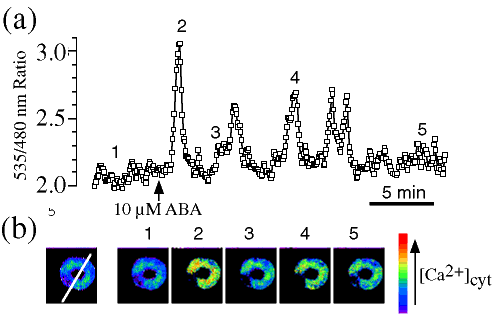Many physiological stimuli in plant cells induce elevations in the cytoplasmic free calcium concentration that acts as an essential second messenger in plant signal transduction cascades. The stomatal guard cell is a model cell system for calcium-based signal transduction studies in plants because a wide variety of signals regulate guard cell turgor by modulating cytoplasmic calcium. Measuring cytoplasmic calcium in guard cells has previously required loading of calcium sensitive dyes using invasive and technically difficult microinjection approaches, or using acid (Bush and Jones 1987, Cell Calcium 8, 455-472; Allen etal., 1999, The Plant Cell 11, 1785-1798) or AM-ester loading techniques (see "Calcium Green and Fluo Ester Loading in Guard Cells" on this web site). To circumvent these problems we have constitutively expressed the green florescent protein based calcium indicator yellow cameleon 2.1 (YC2.1) (Miyawaki et al., 1999, Proc. Natl. Acad. Sci. USA 96, 2135-2140) in Arabidopsis thaliana under control of the 35S promoter. The YC2.1 calcium indicator is expressed in guard cells and accumulates predominantly in the cytosol. Fluorescence ratio imaging of YC2.1 allows time-dependent, quantitative measurement of cytoplasmic calcium in Arabidopsis guard cells. Increases in external calcium can induce repetitive cytoplasmic calcium transients in guard cells of up to 1.5 m M. The hormone ABA also induced repetitive cytoplasmic calcium transients of up to 600 nM (Figure 1). YC2.1 is expressed in both guard cells allows, for the first time, cytoplasmic calcium to be measured independently in two guard cells of a single pair. Interestingly, the two cells do not necessarily respond with the same calcium signature to identical stimuli. Overall, these data demonstrate that that GFP-based calcium indicators are suitable to measure cytoplasmic calcium changes in plant cells and enable calcium dynamics to be measured in guard cells of Arabidopsis. This technical advance in combination with molecular biological and genetic approaches will become an invaluable tool in the molecular dissection of plant cell signal transduction. More data demonstrating cameleon function in Arabidopsis guard cells can be found in the paper: Allen G.J., Kwak, J.M., Chu, S.P., Llopis, J., Tsien, R.Y., Harper, J.F., and Schroeder, J.I. (1999), Cameleon calcium indicator reports cytoplasmic calcium dynamics in Arabidopsis guard cells, The Plant Journal, 19, 735-747.

Figure1. (a) Cytosolic calcium transients elicited by the hormone abscisic acid (ABA) in an Arabidopsis guard cell expressing the calcium indicator yellow cameleon 2.1. An increase in cytosolic calcium is reported by an increase in the fluorescence emission ratio 535/480nm. (b) Ratio images of cameleon fluorescence in guard cells responding to ABA. The trace in (a) is taken from the left-hand cell; images are shown at the points marked.